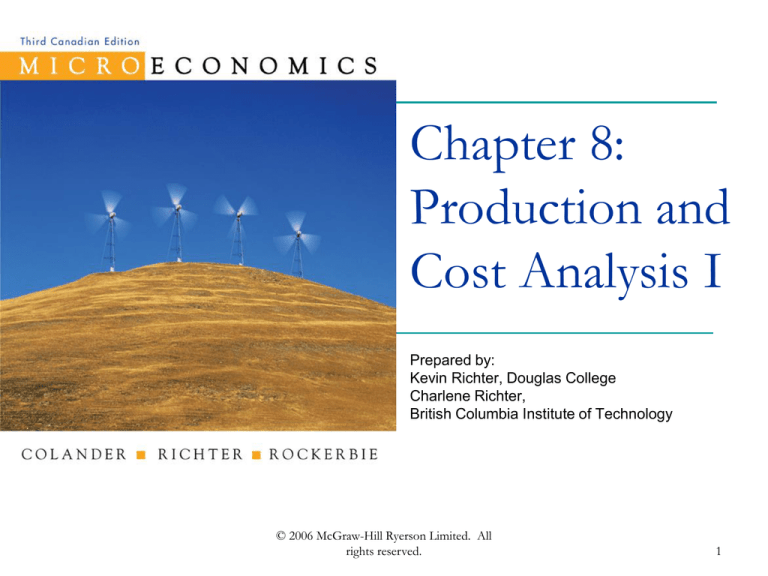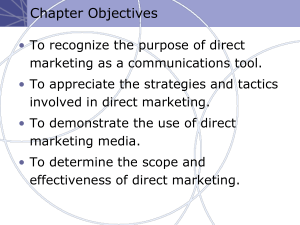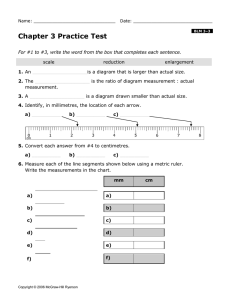
Chapter 8:
Production and
Cost Analysis I
Prepared by:
Kevin Richter, Douglas College
Charlene Richter,
British Columbia Institute of Technology
© 2006 McGraw-Hill Ryerson Limited. All
rights reserved.
1
Introduction
In the supply process, people first offer their
factors of production to the market.
Then the factors are transformed by firms into
goods that consumers want.
Production is the name given to that
transformation of factors into goods.
© 2006 McGraw-Hill Ryerson Limited. All
rights reserved.
2
Role of the Firm
The firm is an economic institution that
transforms factors of production into
consumer goods.
Organizes factors of production.
Produces goods and services.
Sells produced goods and services.
© 2006 McGraw-Hill Ryerson Limited. All
rights reserved.
3
Forms of Business
There are three major types of businesses:
sole proprietorships
partnerships
corporations.
© 2006 McGraw-Hill Ryerson Limited. All
rights reserved.
4
Sole Proprietorship
Businesses that have only one owner.
Advantages:
Minimum bureaucratic hassle.
Direct control by owner.
Disadvantages:
Limited ability to get funds.
Unlimited personal liability.
© 2006 McGraw-Hill Ryerson Limited. All
rights reserved.
5
Partnership
Businesses with two or more owners.
Advantages:
Ability to share work and risks.
Relatively easy to form.
Disadvantages:
Unlimited personal liability (even for partner's
blunder).
Limited ability to get funds.
© 2006 McGraw-Hill Ryerson Limited. All
rights reserved.
6
Corporation
Businesses that are treated as a person and
are legally owned by their stockholders who
are not liable for the actions of the corporate
"person."
© 2006 McGraw-Hill Ryerson Limited. All
rights reserved.
7
Corporation
Advantages:
No personal liability.
Increased ability to get funds.
Ability to shed personal income and gain added
expenses.
© 2006 McGraw-Hill Ryerson Limited. All
rights reserved.
8
Corporation
Disadvantages:
Legal hassle to organize.
Possible double taxation of income.
Monitoring problems.
© 2006 McGraw-Hill Ryerson Limited. All
rights reserved.
9
Forms of Business
© 2006 McGraw-Hill Ryerson Limited. All
rights reserved.
10
The Firm and the Market
A firm operates within the market and,
simultaneously, it abandons the market in the
sense that it replaces the market with
command and control.
© 2006 McGraw-Hill Ryerson Limited. All
rights reserved.
11
The Firm and the Market
How an economy operates depends on
transaction costs — the costs of
undertaking trades through the market.
© 2006 McGraw-Hill Ryerson Limited. All
rights reserved.
12
The Firm and the Market
Firms are the production organizations that
translate factors of production into consumer
goods.
A firm’s goal is to maximize profits.
© 2006 McGraw-Hill Ryerson Limited. All
rights reserved.
13
Firms Maximize Profit
Profit is the difference between total revenue
and total cost.
Profit = total revenue – total cost
© 2006 McGraw-Hill Ryerson Limited. All
rights reserved.
14
Firms Maximize Profit
For an economist,the measure of profit is
revenues minus both implicit costs and
explicit costs.
An accountant will calculate profit by
subtracting explicit costs from the revenue.
© 2006 McGraw-Hill Ryerson Limited. All
rights reserved.
15
Firms Maximize Profit
For an economist, total cost is explicit
payments to factors of production plus the
opportunity cost of the factors provided by the
owners of the firm, which is an implicit cost.
© 2006 McGraw-Hill Ryerson Limited. All
rights reserved.
16
Firms Maximize Profit
For economists:
Economic Profit =
total revenue – (implicit and explicit cost)
© 2006 McGraw-Hill Ryerson Limited. All
rights reserved.
17
Production Process
The production process generally divided into
the long run planning decision and the short
run adjustment decision.
© 2006 McGraw-Hill Ryerson Limited. All
rights reserved.
18
The Long Run and the Short Run
A long-run decision is a decision in which
the firm can choose the least expensive
method of producing from among all possible
production techniques.
© 2006 McGraw-Hill Ryerson Limited. All
rights reserved.
19
The Long Run and the Short Run
A short-run decision is one in which the firm
is constrained by past choices in regard to
what production decision it can make.
© 2006 McGraw-Hill Ryerson Limited. All
rights reserved.
20
The Long Run and the Short Run
The terms long run and short run do not
necessarily refer to specific periods of time.
They refer to the degree of flexibility the firm
has in changing the level of output.
© 2006 McGraw-Hill Ryerson Limited. All
rights reserved.
21
The Long Run and the Short Run
In the long run, all inputs are variable.
In the short run:
Flexibility is limited.
Some factors of production cannot be changed.
Generally, the production facility (“the plant”) is
fixed.
© 2006 McGraw-Hill Ryerson Limited. All
rights reserved.
22
Production Table
A production table shows the output
resulting from various combinations of factors
of production, or inputs.
© 2006 McGraw-Hill Ryerson Limited. All
rights reserved.
23
Production Table
Most of the production decisions firms make
are short run decisions involving changes in
output at a given production facility.
The firm can increase or decrease production
by adjusting the amount of variable inputs,
such as labour or materials.
© 2006 McGraw-Hill Ryerson Limited. All
rights reserved.
24
Production Table
Total product is the number of units of the
good or service produced by different
numbers of workers.
© 2006 McGraw-Hill Ryerson Limited. All
rights reserved.
25
Production
Marginal product is the additional output
that will be forthcoming from an additional
worker, other inputs remaining constant.
Average product is calculated by dividing
total output by the number of workers who
produced it.
© 2006 McGraw-Hill Ryerson Limited. All
rights reserved.
26
Production Functions
Production function – a curve that
describes the relationship between the inputs
(factors of production) and output.
© 2006 McGraw-Hill Ryerson Limited. All
rights reserved.
27
Production Functions
The production function tells the maximum
amount of output that can be derived from a
given number of inputs.
© 2006 McGraw-Hill Ryerson Limited. All
rights reserved.
28
Production Table
Number of
workers
Total output
Marginal
product
Average
product
0
1
2
3
4
5
6
7
8
9
10
0
4
10
17
23
28
31
32
32
30
25
4
6
7
6
5
3
1
0
2
5
—
4
5
5.7
5.8
5.6
5.2
4.6
4.0
3.3
2.5
© 2006 McGraw-Hill Ryerson Limited. All
rights reserved.
29
32
30
28
26
24
22
20
18
16
14
12
10
8
6
4
2
0
7
6
TP
5
Output per worker
Output
Production Function
4
3
2
AP
1
1
2
(a) Total product
3 4 5 6 7
Number of workers
8
9
10
0
1
2
3 4 5 6 7
Number of workers
(b) Marginal and average product
© 2006 McGraw-Hill Ryerson Limited. All
rights reserved.
8
9
MP
10
30
Diminishing Marginal Productivity
Both marginal and average productivities
initially increase, but eventually they both
decrease.
© 2006 McGraw-Hill Ryerson Limited. All
rights reserved.
31
Diminishing Marginal Productivity
This means that initially the production
function exhibits increasing marginal
productivity.
Then it exhibits diminishing marginal
productivity.
Finally, it exhibits negative marginal
productivity.
© 2006 McGraw-Hill Ryerson Limited. All
rights reserved.
32
Diminishing Marginal Productivity
The most relevant part of the production
function is that part exhibiting diminishing
marginal productivity.
© 2006 McGraw-Hill Ryerson Limited. All
rights reserved.
33
Diminishing Marginal Productivity
Law of diminishing marginal productivity
– as more and more of a variable input is
added to an existing fixed input, after some
point the additional output one gets from the
additional input will fall.
© 2006 McGraw-Hill Ryerson Limited. All
rights reserved.
34
Diminishing Marginal Productivity
Number of
workers
Total
output
Marginal
product
Average
product
0
1
2
3
4
5
6
7
8
9
10
0
4
10
17
23
28
31
32
32
30
25
4
6
7
6
5
3
1
0
2
5
—
4
5
5.7
5.8
5.6
5.2
4.6
4.0
3.3
2.5
© 2006 McGraw-Hill Ryerson Limited. All
rights reserved.
Increasing
marginal returns
Diminishing
marginal returns
Diminishing
absolute returns
35
Diminishing Marginal Productivity
Diminishing
absolute
returns
32
30
28
26
24
22
20 Increasing
18
16 marginal
returns
14
12
10
8
6
4
2
0
1 2 3 4 5 6 7
Number of workers
(a) Total product
Diminishing
marginal
returns
7
Diminishing
absolute
returns
6
TP
5
Output per worker
Output
Diminishing
marginal
returns
4
3
2 Increasing
1
8
9
10
0
AP
marginal
returns
1
2
3 4 5 6 7
Number of workers
(b) Marginal and average product
© 2006 McGraw-Hill Ryerson Limited. All
rights reserved.
8
9
MP
10
36
Diminishing Marginal Productivity
This law is sometimes called the flowerpot
law.
If it did not hold true, the world’s entire food
supply could be grown in a single flower pot.
© 2006 McGraw-Hill Ryerson Limited. All
rights reserved.
37
Costs of Production
Costs of production in the short run are:
Fixed Costs,
Variable Costs, and
Total Costs.
© 2006 McGraw-Hill Ryerson Limited. All
rights reserved.
38
Fixed Costs
Fixed costs are those that cannot be
changed in the period of time under
consideration regardless of output.
In the long run there are no fixed costs since all
costs are variable.
In the short run, a number of costs will be fixed.
© 2006 McGraw-Hill Ryerson Limited. All
rights reserved.
39
Variable Costs
Variable costs are costs that change as
output changes, such as the costs of labour
and materials.
© 2006 McGraw-Hill Ryerson Limited. All
rights reserved.
40
Fixed Costs, Variable Costs, and Total
Costs
The sum of the fixed costs and variable costs
are total costs.
TC = FC + VC
© 2006 McGraw-Hill Ryerson Limited. All
rights reserved.
41
Average Costs
Besides total costs, firms are concerned with
their costs per unit of output.
Per unit costs are
Average Total Cost,
Average Fixed Cost, and
Average Variable Cost
© 2006 McGraw-Hill Ryerson Limited. All
rights reserved.
42
Average Costs
Average total cost (often called average
cost) equals total cost divided by the quantity
produced.
ATC = TC/Q
© 2006 McGraw-Hill Ryerson Limited. All
rights reserved.
43
Average Costs
Average fixed cost equals fixed cost divided
by quantity produced.
AFC = FC/Q
© 2006 McGraw-Hill Ryerson Limited. All
rights reserved.
44
Average Costs
Average variable cost equals variable cost
divided by quantity produced.
AVC = VC/Q
© 2006 McGraw-Hill Ryerson Limited. All
rights reserved.
45
Average Costs
Average total cost can also be thought of as
the sum of average fixed cost and average
variable cost.
ATC = AFC + AVC
© 2006 McGraw-Hill Ryerson Limited. All
rights reserved.
46
Marginal Cost
Marginal cost is the increase in total cost of
increasing the level of output by one unit,
MC = TC/Q
In deciding how many units to produce, the
most important variable is marginal cost.
© 2006 McGraw-Hill Ryerson Limited. All
rights reserved.
47
The Cost of Producing Earrings
Output
FC
VC
TC
MC
AFC
AVC
ATC
3
4
9
10
16
17
22
23
27
28
50
50
50
50
50
50
50
50
50
50
38
50
100
108
150
157
200
210
255
270
88
100
150
158
200
207
250
260
305
320
—
12
—
8
—
7
—
10
—
15
16.67
12.50
5.56
5.00
3.13
2.94
2.27
2.17
1.85
1.79
12.66
12.50
11.11
10.80
9.38
9.24
9.09
9.13
9.44
9.64
29.33
25.00
16.67
15.80
12.50
12.18
11.36
11.30
11.30
11.42
© 2006 McGraw-Hill Ryerson Limited. All
rights reserved.
48
Graphing Cost Curves
To gain a greater understanding of these
concepts, it is a good idea to draw a graph.
Quantity is plotted on the horizontal axis and
a dollar measure of various costs on the
vertical axis.
© 2006 McGraw-Hill Ryerson Limited. All
rights reserved.
49
Total Cost Curves
Total cost rises with output.
The total variable cost curve has the same
shape as the total cost curve—increasing
output increases variable cost.
© 2006 McGraw-Hill Ryerson Limited. All
rights reserved.
50
Total cost
Total Cost Curves
$400
350
300
250
200
150
100
50
0
TC
VC
TC = (VC + FC)
L
O
M
2 4 6 8 10
FC
20
Quantity of earrings
© 2006 McGraw-Hill Ryerson Limited. All
rights reserved.
30
51
Average Fixed Cost Curve
The average fixed cost curve slopes down
continuously.
© 2006 McGraw-Hill Ryerson Limited. All
rights reserved.
52
Average Fixed Cost Curve
The average fixed cost curve looks like a
child’s slide – it starts out with a steep
decline, then it becomes flatter and flatter.
It tells us that as output increases, the same
fixed cost can be spread out over a wider
range of output.
© 2006 McGraw-Hill Ryerson Limited. All
rights reserved.
53
Increasing Output in the Short Run
In the short run, output can only be increased
by increasing the variable input.
© 2006 McGraw-Hill Ryerson Limited. All
rights reserved.
54
U-Shaped Cost Curves
The law of diminishing marginal productivity
sets in as more and more of a variable input
is added to a fixed input.
Marginal and average productivities fall and
marginal costs rise.
© 2006 McGraw-Hill Ryerson Limited. All
rights reserved.
55
U-Shaped Cost Curves
And when average productivity of the variable
input falls, average variable cost rises.
© 2006 McGraw-Hill Ryerson Limited. All
rights reserved.
56
U-Shaped Cost Curves
The average total cost curve is the vertical
summation of the average fixed cost curve
and the average variable cost curve.
© 2006 McGraw-Hill Ryerson Limited. All
rights reserved.
57
U-Shaped Cost Curves
If the firm increased output enormously, the
average variable cost curve and the average
total cost curve would almost meet.
© 2006 McGraw-Hill Ryerson Limited. All
rights reserved.
58
Cost
Per Unit Cost Curves
$30
28
26
24
22
20
18
16
14
12
10
8
6
4
2
0
MC
ATC
AVC
AFC
2 4 6 8 10 12 14 16 18 20 22 2426 28 30 32
Quantity of earrings
© 2006 McGraw-Hill Ryerson Limited. All
rights reserved.
59
Relationship Between Productivity and
Costs
The shapes of the cost curves are mirrorimage reflections of the shapes of the
corresponding productivity curves.
© 2006 McGraw-Hill Ryerson Limited. All
rights reserved.
60
Relationship Between Productivity and
Costs
When one is increasing, the other is
decreasing.
When one is at a maximum, the other is at a
minimum.
© 2006 McGraw-Hill Ryerson Limited. All
rights reserved.
61
Relationship Between Productivity and
Costs
Costs per unit
$18
16
14
12
10
8
6
4
2
0
MC
AVC
18
21
Output
9
8
7
6
5
4
3
2
1
Output per worker
0
© 2006 McGraw-Hill Ryerson Limited. All
rights reserved.
AP
MP
21/2
4
Labour
62
Relationship Between Marginal and
Average Costs
The marginal cost and average cost curves
are related.
When marginal cost exceeds average cost,
average cost must be rising.
When marginal cost is less than average cost,
average cost must be falling.
© 2006 McGraw-Hill Ryerson Limited. All
rights reserved.
63
Relationship Between Marginal and
Average Costs
This relationship explains why marginal cost
curves always intersect average cost curves
at the minimum of the average cost curve.
© 2006 McGraw-Hill Ryerson Limited. All
rights reserved.
64
Relationship Between Marginal and
Average Costs
The position of the marginal cost relative to
average total cost tells us whether average
total cost is rising or falling.
© 2006 McGraw-Hill Ryerson Limited. All
rights reserved.
65
Relationship Between Marginal and
Average Costs
To summarize:
If MC > ATC, then ATC is rising.
If MC = ATC, then ATC is at its minimum.
If MC < ATC, then ATC is falling.
© 2006 McGraw-Hill Ryerson Limited. All
rights reserved.
66
Relationship Between Marginal and
Average Costs
Marginal and average total cost reflect a
general relationship that also holds for
marginal cost and average variable cost.
If MC > AVC, then AVC is rising.
If MC = AVC, then AVC is at its minimum.
If MC < AVC, then AVC is falling.
© 2006 McGraw-Hill Ryerson Limited. All
rights reserved.
67
Relationship Between Marginal and
Average Costs
As long as average variable cost does not
rise by more than average fixed cost falls,
average total cost will fall when marginal cost
is above average variable cost.
© 2006 McGraw-Hill Ryerson Limited. All
rights reserved.
68
Relationship Between Marginal and
Average Costs
$90
80
70
60
50
40
30
20
10
0
MC
Area A
Area C
Area B
ATC
AVC
B
1
2
3
A
Q0 Q1
4 5 6
7
© 2006 McGraw-Hill Ryerson Limited. All
rights reserved.
8
9 Quantity
69
Production and
Cost Analysis I
End of Chapter 8
© 2006 McGraw-Hill Ryerson Limited. All
rights reserved.
70




